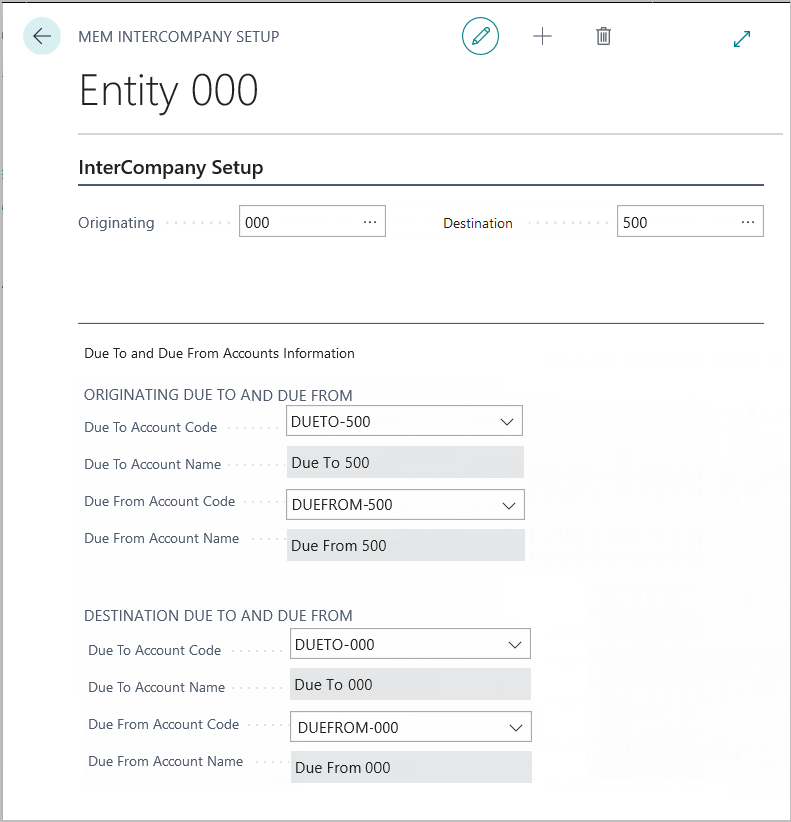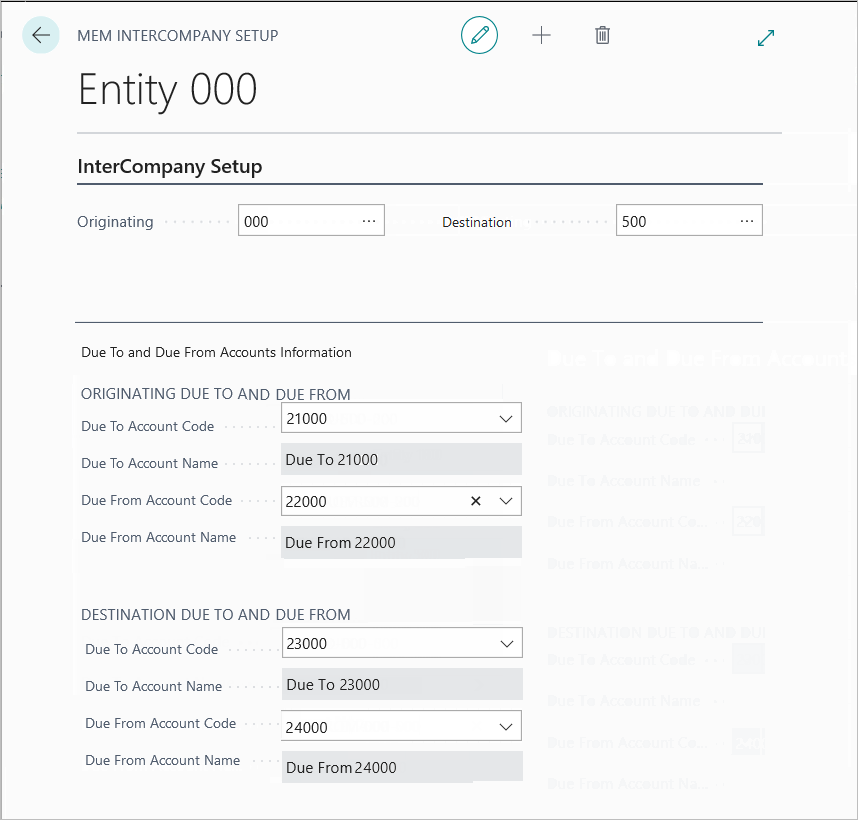In this article
Intercompany: Examples
Review the following example to better understand how the intercompany functionality works.
Originating 000 with Destination 500
The page has the following setup:

When a general journal is created for entity 000, the following intercompany distributions are created:
| Entity | Account | Debit | Credit | |
| 500 | 4500 | 100 | (original distribution) | |
| 000 | 1200 | 100 | (original distribution) | |
| 000 | DUEFROM-500 | 100 | (intercompany distribution) | |
| 500 | DUETO-000 | 100 | (intercompany distribution) |
Consider the opposite example. A general journal is created for entity 000.
| Entity | Account | Debit | Credit | |
| 000 | 1200 | 100 | (original distribution) | |
| 500 | 4500 | 100 | (original distribution) | |
| 500 | DUEFROM-000 | 100 | (intercompany distribution) | |
| 000 | DUETO-500 | 100 | (intercompany distribution) |
Originating 100 with Destination 500
The page has the following setup:

When a general journal is created for entity 100, the following intercompany distributions are created:
| Entity | Account | Debit | Credit | |
| 500 | 4500 | 100 | (original distribution) | |
| 100 | 1200 | 100 | (original distribution) | |
| 100 | 142012 | 100 | (intercompany distribution) | |
| 500 | 210115 | 100 | (intercompany distribution) |
Originating 100 with Destination 200
The page has the following setup:


Intercompany with Dimensions
Review this example to better understand how the intercompany functionality works with dimensions.
On the Multi-Entity Management Setup page, the following additional intercompany dimensions are selected:
- IC Dimension 1 Code: PROJECT
- IC Dimension 2 Code: FUND
- IC Dimension 3 Code: CUSTOMERGROUP
For the additional intercompany dimensions, the setup on the MEM Additional Intercompany Setup page is as follows:
| Additional Intercompany Dimension: PROJECT | |
| Originating | 10 |
| Due To Account Code | 10-DUE-TO-20 |
| Due To Account Name | 10-Due-To-20 |
| Due From Account Code | 10-DUE-FROM-20 |
| Due From Account Name | 10-Due-From-20 |
| Destination | 20 |
| Due To Account Code | 20-DUE-TO-10 |
| Due To Account Name | 20-Due-To-10 |
| Due From Account Code | 20-DUE-FROM-10 |
| Due From Account Name | 20-Due-From-10 |
| Originating | 20 |
| Due To Account Code | 20100 |
| Due To Account Name | 20-Due-To-10 |
| Due From Account Code | 10200 |
| Due From Account Name | 20-Due-From-10 |
| Destination | 10 |
| Due To Account Code | 10300 |
| Due To Account Name | 10-Due-To-20 |
| Due From Account Code | 10400 |
| Due From Account Name | 10-Due-From-20 |
| Additional Intercompany Dimension: FUND | |
| Originating | A |
| Due To Account Code | A-DUE-TO-B |
| Due To Account Name | A-Due-To-B |
| Due From Account Code | A-DUE-FROM-B |
| Due From Account Name | A-Due-From-B |
| Destination | B |
| Due To Account Code | B-DUE-TO-A |
| Due To Account Name | B-Due-To-A |
| Due From Account Code | B-DUE-FROM-A |
| Due From Account Name | B-Due-From-A |
| Originating | B |
| Due To Account Code | 20100 |
| Due To Account Name | B-Due-To-A |
| Due From Account Code | 10200 |
| Due From Account Name | B-Due-From-A |
| Destination | A |
| Due To Account Code | 10300 |
| Due To Account Name | A-Due-To-B |
| Due From Account Code | 10400 |
| Due From Account Name | A-Due-From-B |
| Additional Intercompany Dimension: CUSTOMER GROUP | |
| Originating | LARGE |
| Due To Account Code | LARGE-DUE-TO-SMALL |
| Due To Account Name | LARGE-Due-To-SMALL |
| Due From Account Code | LARGE-DUE-FROM-SMALL |
| Due From Account Name | LARGE-Due-From-SMALL |
| Destination | SMALL |
| Due To Account Code | SMALL-DUE-TO-LARGE |
| Due To Account Name | SMALL-Due-To-LARGE |
| Due From Account Code | SMALL-DUE-FROM-LARGE |
| Due From Account Name | SMALL-Due-From-LARGE |
On the Sales Invoice page, create a transaction with the following settings:
- In the header, set Department Code to PROD.
- Select Invoice > Dimensions to add additional dimensions for the invoice:
- DEPARTMENT
- PROD
- FUND
- CUSTOMERGROUP
- Add one line:
- Department Code: PROD
- Customer Group: LARGE
- Type: G/L Account
- No.: 10100
- Quantity: 1
- Unit Price Excl. Tax: 100.00
- Line Amount Excl. Tax: 100.00
- For the line select Line > Related Information > Dimensions, to change the dimensions for the line.
- CUSTOMERGROUP: SMALL
- DEPARTMENT: ADM
- FUND: B
- PROD: 20
- Preview the posting to review the G/L entries:
- Post the invoice, and then select Invoice > Navigate.


The following image provides further explanation of the intercompany distributions.
